Every sound we hear is created by vibrations that travel through the air. The speed of these vibrations determines the music frequencies. For instance, faster vibrations create high-frequency sounds, while slower vibrations create low-frequency sounds. In this guide, we’ll explore the complete frequency distribution in music and explain what they do.
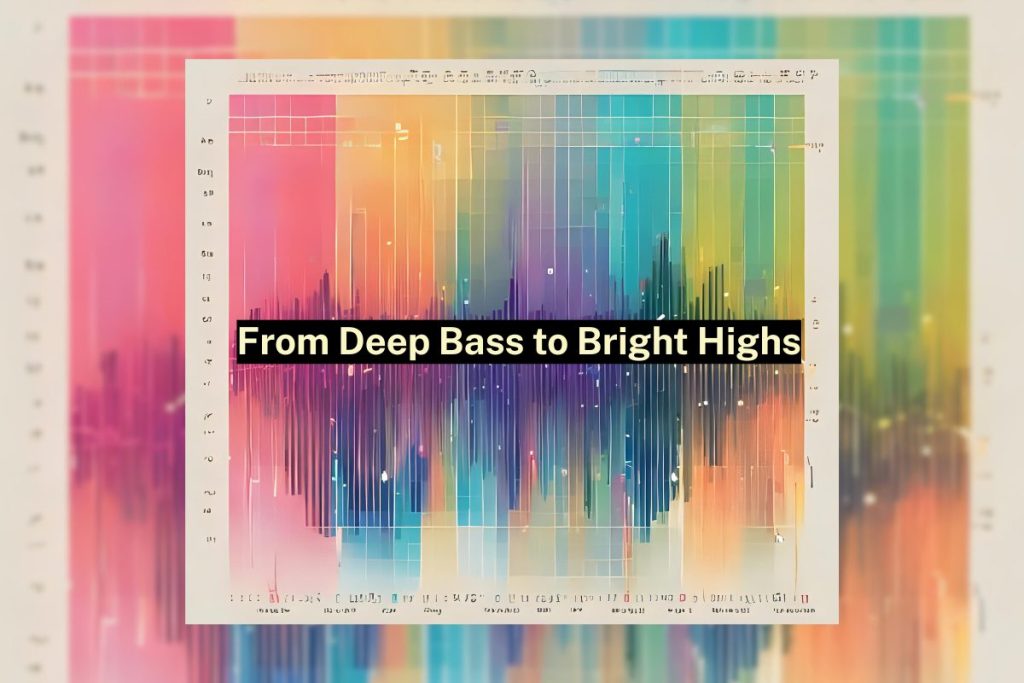
Table of Contents:
What are the Audio Frequency ranges?
The 7 Ranges of Frequency Distribution
What are the Audio Frequency ranges?
| Frequency Ranges | Frequency | Note |
| Sub Bass | 20 Hz – 60 Hz | Adds deep rumble and physical weight. |
| Bass | 60 Hz – 250 Hz | Adds punch, warmth, and groove. |
| Low-Mids | 250 Hz – 500 Hz | Adds body to instruments and vocals. |
| Mid-Range | 500 Hz – 2 kHz | Carries vocals and main instruments. |
| High-Mids | 2 kHz – 4 kHz | Brings attack, bite, and definition. |
| Presence | 4 kHz – 6 kHz | Brings clarity and focus |
| Highs | 6 kHz – 20 kHz | Adds sparkle, air, and brightness. |
The audio frequency spectrum ranges from 20 Hz to 20,000 Hz, which includes the full range of sounds the human ear can hear. Within this range are smaller frequency bands, each with its own sound and purpose. Some frequencies are more felt than heard, like deep bass, while others bring clarity and presence, like crisp highs. Understanding these frequency ranges is key to shaping sound in music production and song design.
The 7 Ranges of Frequency Distribution

Sub bass (20 Hz – 60 Hz)
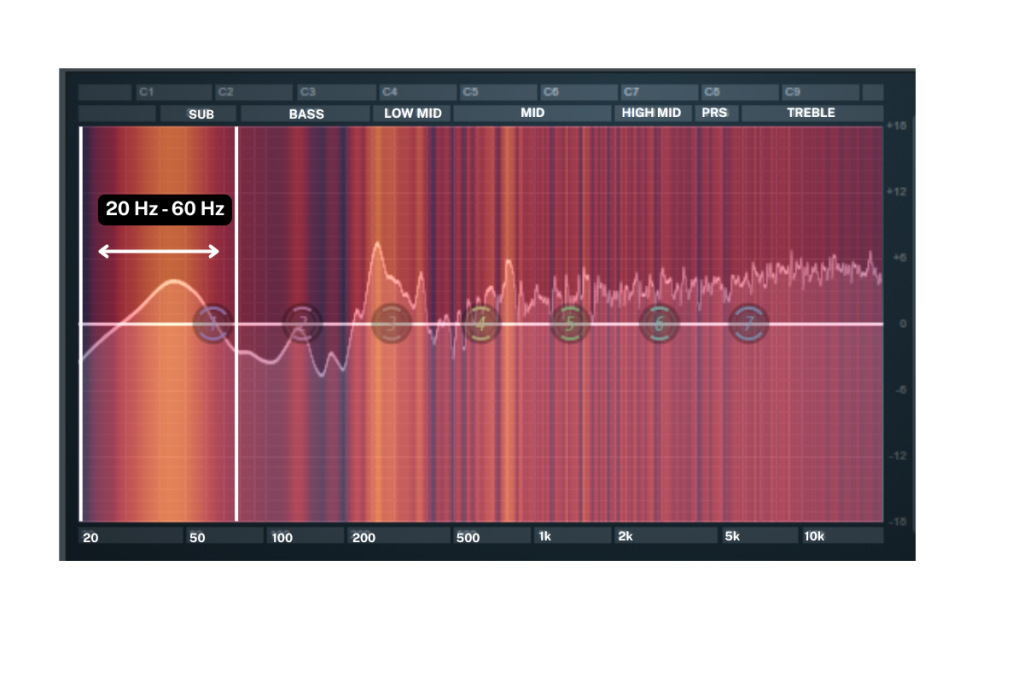
Sub bass sits at the very bottom of the spectrum. The music frequencies in this particular band range from 20 Hz to 60 Hz. This range is more felt than heard. For example, you sense it as a rumble or vibration in your chest rather than a distinct tone when a subwoofer hits.
When used well, sub bass adds depth and power to a song. But if overused or poorly controlled, it can easily make your mix sound muddy or overwhelming.
Bass (60 Hz – 250 Hz)
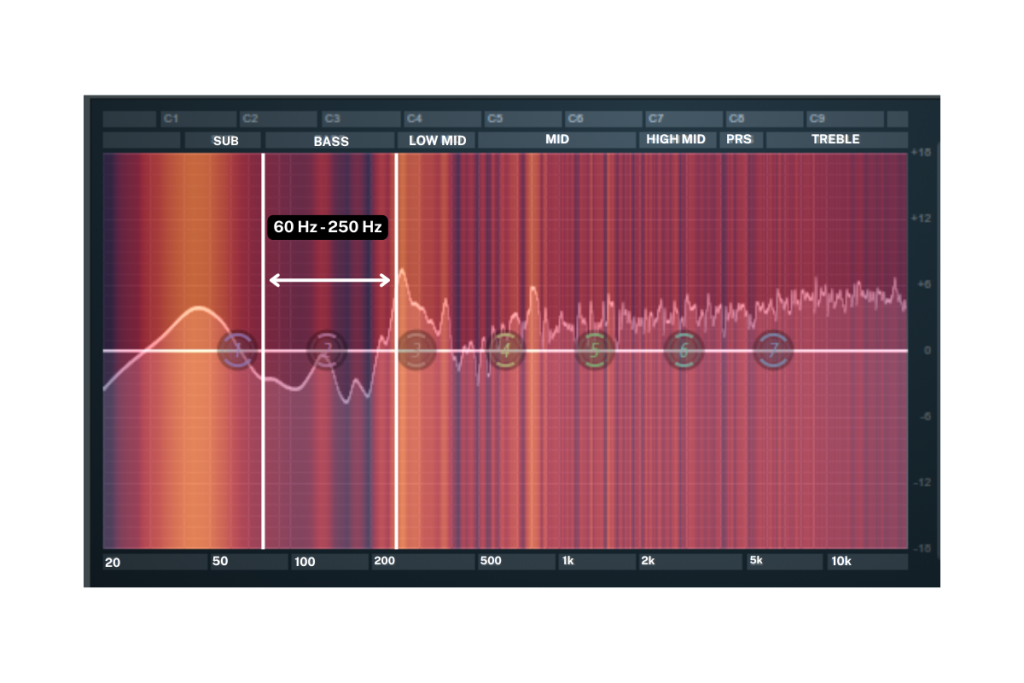
Bass frequencies range from 60 Hz to 250 Hz and play a key role in making a track sound fuller, fatter, and heavier. This range adds body and energy to a mix, but just like sub bass, it can also cause muddiness if not handled carefully. When balanced well, the bass gives a song a solid and grounded feel.
Even acoustic instruments, such as guitars, can produce unwanted bass frequencies that should be cleaned up for better clarity.
Tip: Use EQ to shape the bass and avoid overlaps with the sub bass and low mids for a cleaner frequency distribution.
Low Mids (250 Hz – 500 Hz)
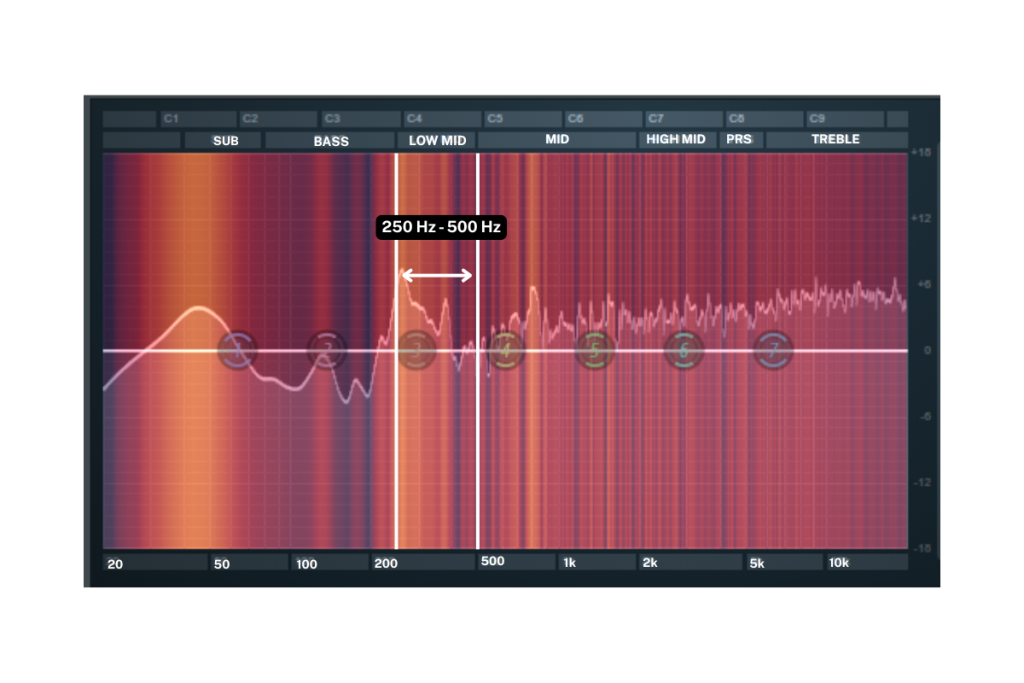
Low-mid frequencies fall between 250 Hz and 500 Hz and act as a transitional zone between the bass and mid-range. The music frequencies in this band often carry the body of vocals and main instruments, adding warmth and thickness. However, too much energy in the low-mids can cause a mix to sound boomy, especially when layered with bass-heavy sounds. Careful EQ adjustments help keep this range clean and balanced.
Mid-range (500 Hz – 2 kHz)
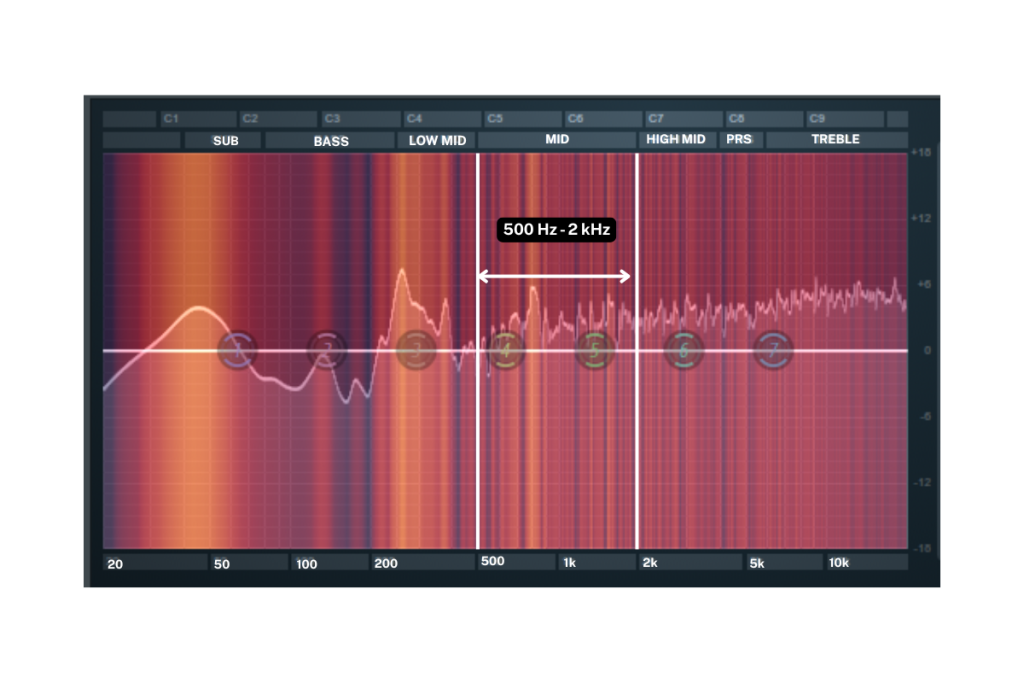
The mid-range, covering 500 Hz to 2 kHz, is one of the most important parts of the audio frequency spectrum. This is where the core frequencies of vocals, melodies, and instruments sit, making it the heart of a song’s frequency distribution. It adds richness, presence, and detail to the overall sound. But because so many elements live here, overlapping frequencies can quickly lead to a cluttered mix. Careful balancing is key to making the track sound clean and professional.
High-Mids (2 kHz – 4 kHz)
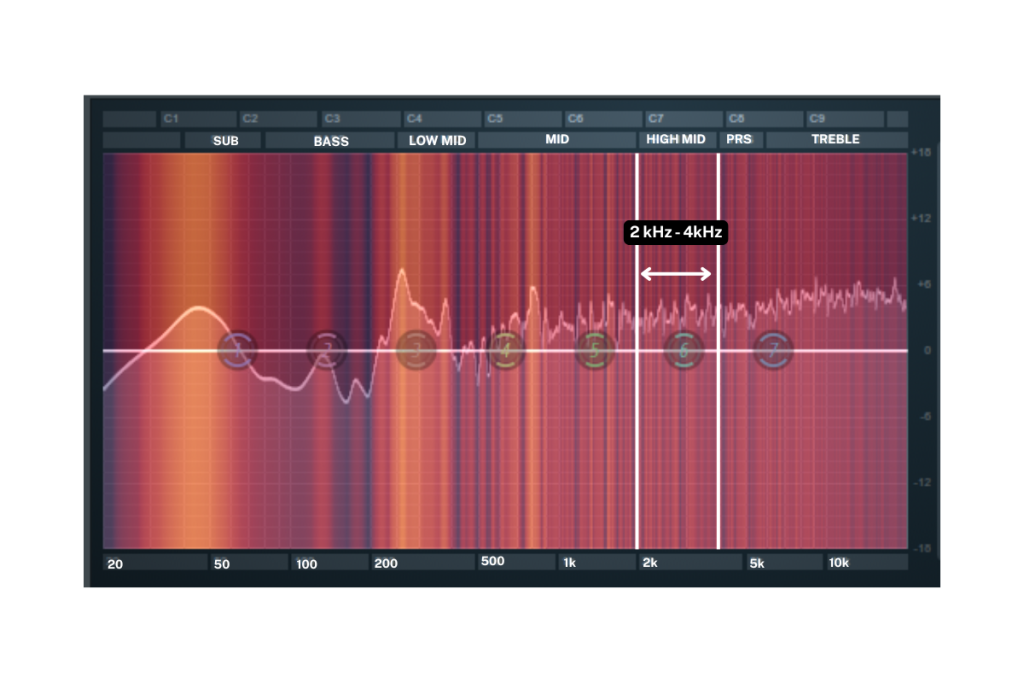
The high-mid frequencies, between 2 kHz and 4 kHz, bring clarity, attack, and definition to a mix. This range helps important sounds like vocals, snare hits, and lead instruments stand out and cut through the mix. It’s often where the sharpness of a voice or the snap of a drum lives. But too much in this range can make the vocals or the song in general sound harsh or piercing, especially at high volumes. Balancing the high-mids ensures your track stays clear without becoming uncomfortable to listen to.
Presence (4khz – 6 kHz)
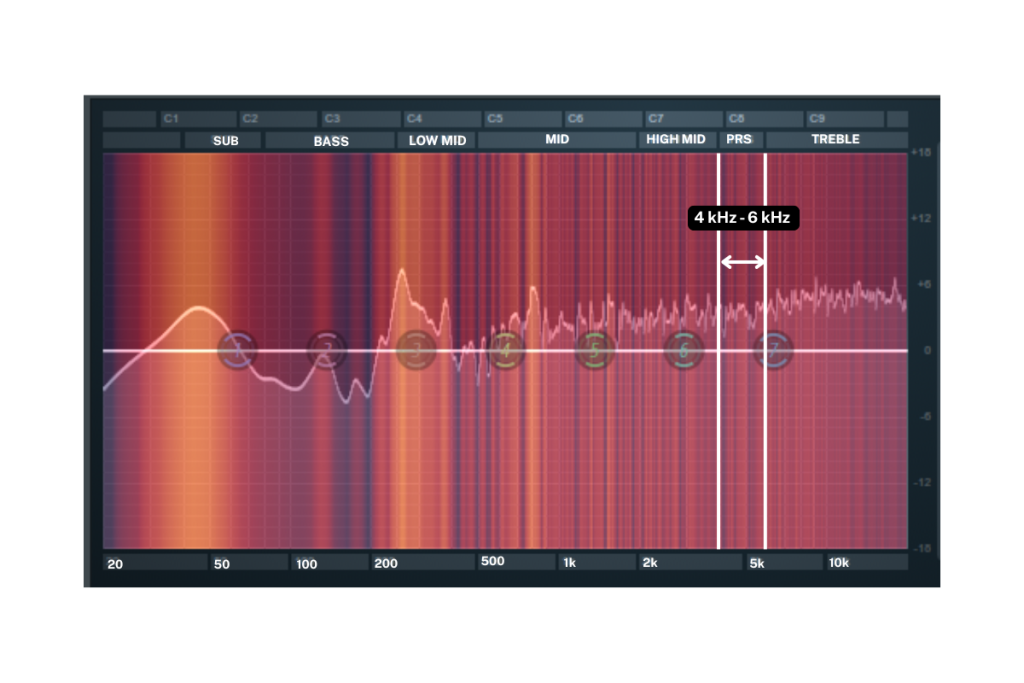
The presence range helps sounds stand out and feel closer to the listener. It adds clarity, sharpness, and focus especially to vocals, guitars, and snares. Boosting this range can make instruments feel more present in the mix, but too much can cause a harsh or thin sound. It’s key for bringing detail without overpowering the ears.
Highs (6 kHz – 20 kHz)
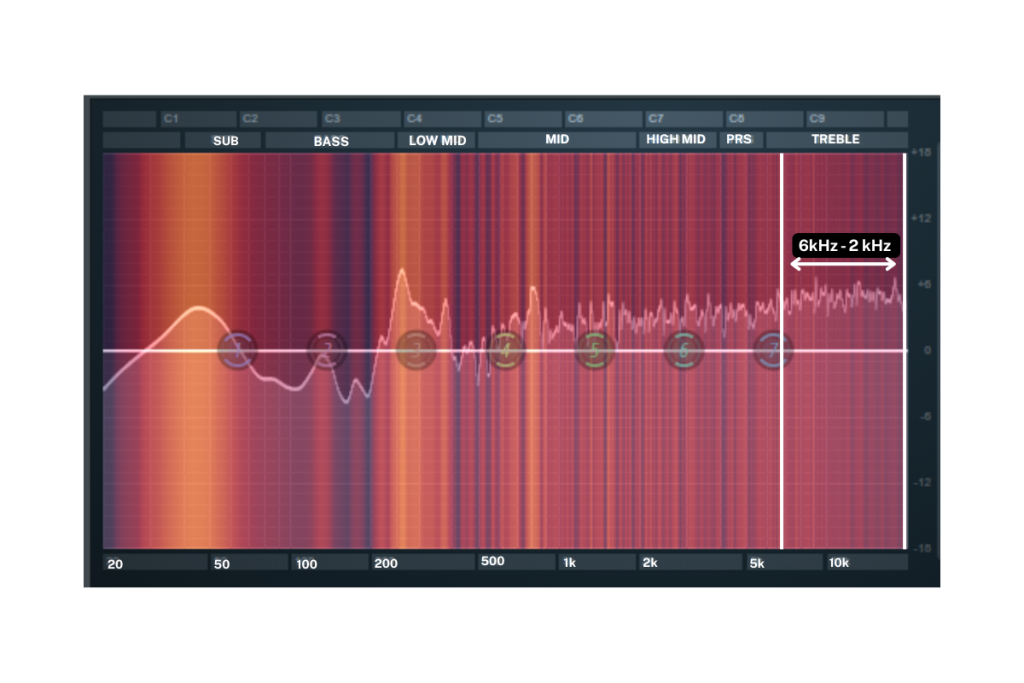
High frequencies fall between 6 kHz and 20 kHz and are heard more than felt, unlike the sub bass. The music frequencies in this part add clarity, brightness, and detail to sounds. For example, boosting the highs can make vocal recordings sound crisp and clear, and help cymbals or hi-hats sparkle in a mix. However, too much can introduce sibilance or create a harsh sound, leading to ear fatigue. This upper end of the spectrum is also referred to as the “air band” because it adds a sense of space and openness to the music.
FAQ
1. What is meant by frequency spectrum?
The frequency spectrum is the full range of music frequencies that we can hear, from low to high. It includes everything from deep sub bass to bright highs, and it’s divided into different bands to help organize and shape sound in music production.
2. What is the range of audio frequency?
The human ear can typically hear frequencies from 20 Hz to 20,000 Hz (20 kHz). This is known as the audio frequency spectrum, and it’s where all musical sounds exist from the lowest rumble to the highest shimmer.
3. What is Hz in audio?
Hz, the abbreviation of Hertz, is a unit that measures the number of sound wave vibrations per second. In audio, it tells you the frequency of a sound. For example, 60 Hz is a low bass frequency, while 10,000 Hz is a high-pitched sound.
4. Which Hz is bass?
Bass frequencies range from 60 Hz to 250 Hz. This range gives music its weight and punch, often heard in bass guitars, kick drums, and deep synths. The sub bass, even lower, starts around 20 Hz.
5. What are the seven frequencies in order?
While breakdowns vary slightly, the common 7 frequency bands in music are:
- Sub Bass (20–60 Hz)
- Bass (60–250 Hz)
- Low Mids (250–500 Hz)
- Mid-Range (500 Hz–2 kHz)
- High Mids (2–6 kHz)
- Highs (6–20 kHz)
Conclusion
Understanding music frequencies is the first step to creating balanced, professional-sounding audio. Each frequency range plays a unique role, from deep sub bass to airy highs. Whether you’re mixing vocals or cleaning up a muddy track, knowing where sounds live in the audio spectrum helps you make smarter decisions. Keep practicing, trust your ears, and use this guide as a simple reference whenever you’re working with sound.
